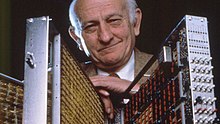John Cocke (computer scientist)
John Cocke | |
|---|---|
 | |
| Born | May 30, 1925 Charlotte, North Carolina, US |
| Died | July 16, 2002 (aged 77) |
| Alma mater | Duke University |
| Known for | RISC CYK algorithm |
| Awards | ACM Turing Award (1987) Computer Pioneer Award (1989) National Medal of Technology (1991) National Medal of Science (1994) IEEE John von Neumann Medal (1994) Computer History Museum Fellow (2002) |
| Scientific career | |
| Fields | Computer Science |
| Institutions | IBM |
John Cocke (May 30, 1925 – July 16, 2002) was an American computer scientist recognized for his large contribution to computer architecture and optimizing compiler design. He is considered by many to be "the father of RISC architecture."[1]
Biography
[edit]He was born in Charlotte, North Carolina, US. He attended Duke University, where he received his bachelor's degree in mechanical engineering in 1946 and his Ph.D. in mathematics in 1956. Cocke spent his entire career as an industrial researcher for IBM, from 1956 to 1992.[2]
Perhaps the project where his innovations were most noted was in the IBM 801 minicomputer, where his realization that matching the design of the architecture's instruction set to the relatively simple instructions actually emitted by compilers could allow high performance at a low cost.
He is one of the inventors of the CYK algorithm (C for Cocke). He was also involved in the pioneering speech recognition and machine translation work at IBM in the 1970s and 1980s, and is credited by Frederick Jelinek with originating the idea of using a trigram language model for speech recognition.[3]
Cocke was appointed IBM Fellow in 1972. He won the Eckert-Mauchly Award in 1985, ACM Turing Award in 1987,[4] the National Medal of Technology in 1991 and the National Medal of Science in 1994,[5][1] IEEE John von Neumann Medal in 1984, The Franklin Institute's Certificate of Merit in 1996, the Seymour Cray Computer Engineering Award in 1999, and The Benjamin Franklin Medal in 2000. He was a member of the American Academy of Arts and Sciences,[6] the American Philosophical Society,[7] and the National Academy of Sciences.[8]
In 2002, he was made a Fellow of the Computer History Museum "for his development and implementation of reduced instruction set computer architecture and program optimization technology."[9]
He died in Valhalla, New York, US.
References
[edit]- ^ a b
Schofield, Jack (2002-07-27). "John Cocke". The Guardian. Retrieved 2011-05-10.
Cocke's idea was to use fewer instructions, but design chips that performed simple instructions very quickly. [...] Later, this approach became known as reduced instruction set computing (Risc) [...]
- ^ Lohr, Steve (2002-07-19). "John Cocke, a Chip Wizard From I.B.M., Is Dead at 77". The New York Times. Retrieved 2024-02-11.
- ^ Jelinek, Frederick, "The Dawn of Statistical ASR and MT", Computational Linguistics, 35(4), 2009, pp. 483-494, doi: 10.1162/coli.2009.35.4.35401
- ^ John Cocke, The search for performance in scientific processors: the Turing Award lecture. Communications of the ACM, Volume 31 Issue 3, March 1988, Pages 250-253. doi:10.1145/42392.42394
- ^ "National Science Foundation - The President's National Medal of Science". Nsf.gov. Retrieved 2014-06-19.
- ^ "John Cocke". American Academy of Arts & Sciences. Retrieved 2021-12-21.
- ^ "APS Member History". search.amphilsoc.org. Retrieved 2021-12-21.
- ^ "John Cocke". www.nasonline.org. Retrieved 2021-12-21.
- ^ "John Cocke". Computer History Museum. Archived from the original on 2013-05-09. Retrieved 2013-05-23.
External links
[edit]- IBM obituary
- Duke profile from 1988 By Eileen Bryn
- Interview transcript
- IEEE John von Neumann Medal Recipients
- 1925 births
- 2002 deaths
- American computer scientists
- Computer hardware engineers
- Computer designers
- Duke University alumni
- 20th-century American mathematicians
- 21st-century American mathematicians
- Turing Award laureates
- National Medal of Science laureates
- National Medal of Technology recipients
- IBM Research computer scientists
- Seymour Cray Computer Engineering Award recipients
- IBM employees
- IBM Fellows
- People from Charlotte, North Carolina
- People from Valhalla, New York
- Mathematicians from New York (state)
- Duke University Pratt School of Engineering alumni
- Members of the United States National Academy of Sciences
- Members of the American Philosophical Society
- The Benjamin Franklin Medal in Computer and Cognitive Science laureates
